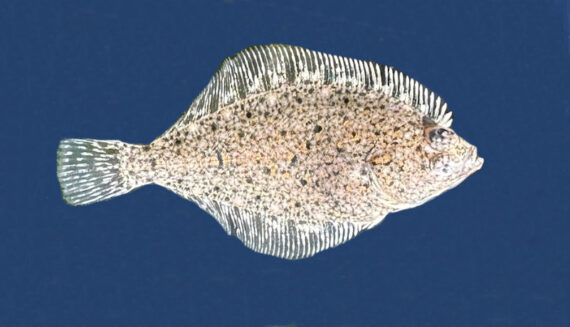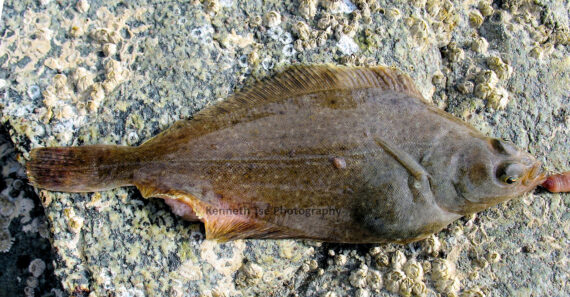English Sole, Parophrys vetulus
 English Sole, Parophrys vetulus. Fish caught from coastal waters off Sitka, Alaska, September 2023. Length: 10.2 cm (5.0 inches). Catch, photograph, and identification courtesy of Luke Ovgard, Stuttgart, Germany.
English Sole, Parophrys vetulus. Fish caught from coastal waters off Sitka, Alaska, September 2023. Length: 10.2 cm (5.0 inches). Catch, photograph, and identification courtesy of Luke Ovgard, Stuttgart, Germany.
 English Sole, Parophrys vetulus. Fish caught out shore in Belcarra, British Columbia, Canada, July 2007. Length: 15.2 cm (6.0 inches). Catch, photograph, and identification courtesy of Kenneth Tse, Toronto, Canada.
English Sole, Parophrys vetulus. Fish caught out shore in Belcarra, British Columbia, Canada, July 2007. Length: 15.2 cm (6.0 inches). Catch, photograph, and identification courtesy of Kenneth Tse, Toronto, Canada.
The English Sole, Parophrys vetulus, is a flatfish that is a member of the Righteye Flounder or Pleuronectidae Family, that is also known as the Lemon Sole and in Mexico as platija limón. Globally, there is one species in the genus Parophrys, this fish that is found in Mexican waters of the Pacific Ocean.
The English Sole has a diamond-shaped, highly compressed body with a depth that is 32% to 36% of standard length. Dorsally they are a uniform dark brown; the ventral side is white to pale yellow in color. Their head is small with a pointed snout, eyes on the right side, at equal depth, with the top eye being on the margin of the head, and an asymmetrical mouth that extends to the lower eye with teeth on both jaws. Their anal fin has 45 to 70 rays; their caudal fin is straight with a wide base; their dorsal fin has 72 to 92 75 rays and originates above the middle of the upper eye; and, their pectoral fins are pointed. They have 14 to 18 gill rakers (4 to 6 on the lower arch and 10 to 13 on the upper arch). Their dorsal side is covered with smooth scales; their ventral size is smooth to the touch. Their lateral line is straight with a slight curve above the pectoral fin.
The English Sole is a demersal species that is found in estuaries and near shore areas with sandy and muddy bottoms at depths up to 550 m (1,800 feet), in waters that range from 4oC (39oF) to 21oC (70oF). They reach a maximum of 61 cm (2 feet 0 inches) in length and 2.3 kg (5 lbs 2 oz) in weight with females being as much as twice the size of males. They are daytime feeders that utilize keen eyesight and smell to detect prey, consuming crustaceans, echinoderms, mollusks, and marine worms that they dig out of the substrate. Their larvae feed on plankton. Their juveniles are one of the few commercially important fishes on the Pacific coast that utilize estuarine areas for 1 to 2 years as nurseries. In turn their juveniles are preyed upon by a wide variety of sea birds, large fish, and marine mammals; the adults are preyed upon by large fish including a wide variety of sharks and marine mammals. Reproduction occurs during the winter and early spring with fish making extensive migrations to historical locations. It occurs over soft muddy bottoms at depths between 50 m (165 feet) and 70 m (230 feet) with each female releasing between 150,000 and 2,000,000 eggs. The eggs hatch and the larvae are found near the surface for 2 or 3 months before they move to near shore estuarine nursery areas where they stay for 1 or 2 years. The females have life spans of up to 23 years; the males to 18 years. The English Sole is poorly studied with very limited information available about their lifestyle and behavioral patterns including specific details on age, growth, longevity, movement patterns, diet, habitat use, and reproduction.
The English Sole is a resident of Mexican waters of the Pacific Ocean but has a limited range being found from just south of Guerrero Negro in Baja California Sur, northward along the central and northwest coasts of Baja.
The English Sole can be confused with the Dover Sole, Microstomus pacificus (body depth 30-34%; lower eye well in front of top eye; very small mouth), the Petrale Sole, Eopsetta jordani (body depth 44-48%), and the Slender Sole, Lyopsetta exillis (body depth 35-39%; covered with large rough scales).
From a conservation perspective the English Sole has not been formally evaluated. Historically they have been considered to be an important commercial catch but catch levels have diminished significantly in recently years. They are heavily regulated in United States waters that include permits, size limits, quantity limits, gear restrictions, and seasonal and area closures. They are caught primarily as a by-catch of deep-water trawlers. They are caught infrequently by recreational anglers. They date to the Miocene era, 5,300,000 years ago.